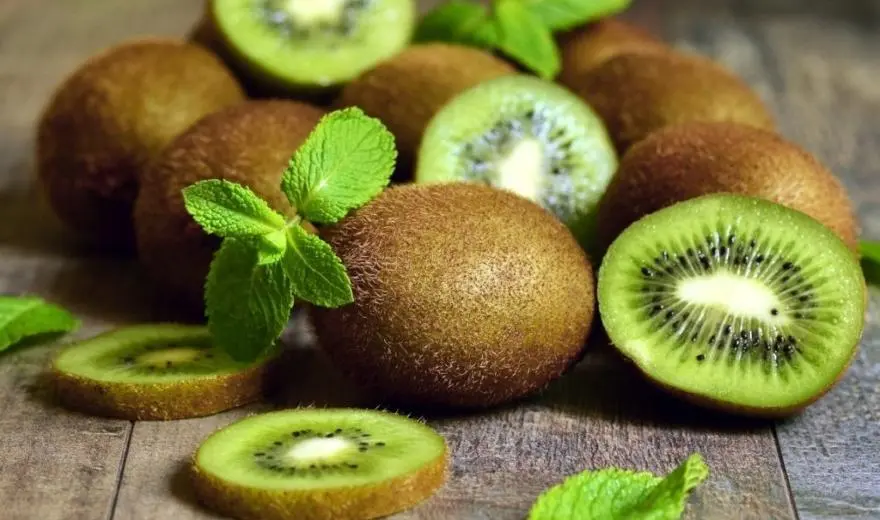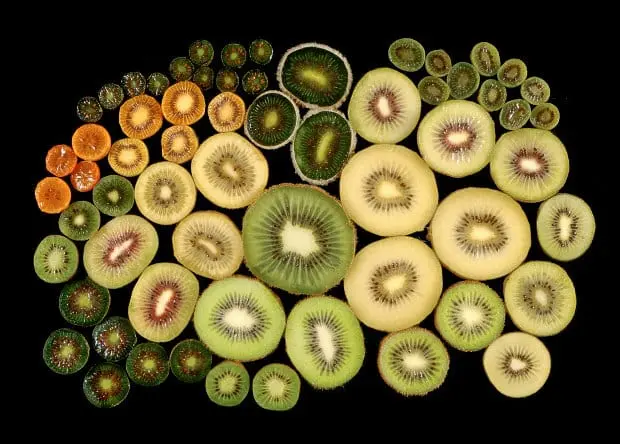Contents
Description
Kiwi is a large oval berry with green flesh and small black seeds inside. The weight of one fruit reaches 100 grams
Kiwi history
Kiwi is one of the “named” fruits. Outwardly, the berry resembles the bird of the same name that lives in New Zealand. The feathered kiwi is featured on the Air Force emblem, various coins and postage stamps.
Kiwi berry is a selection product. It was brought by the New Zealand gardener Alexander Ellison from the wild growing Chinese actinidia in the middle of the 20th century. The original culture weighed only 30 grams and tasted bitter.
Now kiwi is grown in countries with warm climates – in Italy, New Zealand, Chile, Greece. It is from there that kiwis are sent to all countries of the world. As for the Russian territory, fruits with a soft green pulp are grown on the Black Sea coast of the Krasnodar Territory and in the south of Dagestan.
Composition and calorie content

- Caloric content per 100 grams 48 kcal
- Protein 1 gram
- Fat 0.6 grams
- Carbohydrates 10.3 grams
Kiwi is rich in vitamins and minerals such as: vitamin C – 200%, vitamin K – 33.6%, potassium – 12%, silicon – 43.3%, copper – 13%, molybdenum – 14.3%
Kiwi’s benefit
Kiwi contains many vitamins – group B (B1, B2, B6, B9), A and PP. It also contains minerals: potassium, calcium, magnesium, zinc, manganese, chlorine and sulfur, fluorine, phosphorus and sodium.

The fruit is rich in fiber, so it has a beneficial effect on the stomach, promotes digestion, relieves the feeling of heaviness. Vitamin C strengthens the immune system, prevents the spread of infection throughout the body.
It also lowers blood cholesterol levels, promotes the elimination of kidney stones, and strengthens the walls of blood vessels. The fruit is useful for bronchitis as it soothes coughs. It also strengthens teeth and bones, and is good for skin and hair.
Very often, cosmetics manufacturers add kiwi extract to body creams and masks. Such products nourish the skin well and slow down the aging process.
Kiwi harm
In general, kiwi is a harmless food. However, it is not recommended for people with allergies. And also for those who have disorders or diseases of the gastrointestinal tract. For example, gastritis in the acute stage, ulcers, diarrhea, and so on.
Application in medicine
Nutritionists recommend using kiwi for fasting days, as it contains digesting fats and minerals.
One kiwi contains almost a daily requirement of vitamin C. The berry contains dietary fiber that perfectly cleanses our body. Vitamin K is responsible for blood clotting and calcium absorption. The carotenoid lutein improves vision. Copper strengthens connective tissue, improves skin condition. Kiwi is very good at thinning the blood and is very important in preventing blood clots.
But the main thing in kiwi is the enzyme actinidin. It helps to break down the same protein. And if, for example, we had a good dinner, especially heavy meat, barbecue, kiwi breaks down these fibers and facilitates digestion. The only contraindication, there are a lot of oxalates in kiwi. Therefore, this fruit should not be carried away by people who are prone to the formation of kidney stones.
Cooking applications

Kiwi is eaten raw, but it is also cooked. Jam, jams, cakes and even marinade for meat dishes are made from this berry. The only thing is that kiwi does not go well with cottage cheese and fermented milk products, the taste becomes bitter.
How to choose a kiwi
Examine the skin. Evaluate the skin color and texture. The skin of a ripe kiwi should be brown and covered with fine hairs. Be sure to check for dents, dark spots, mildew and wrinkles on the surface of the fruit. Shriveled, crumpled and moldy fruits are overripe and unsuitable for food
Press lightly on the surface of the fruit. Hold the kiwi so that it is between your thumb and the rest of your fingers. Press lightly on the surface of the fruit with your thumb – the surface should be slightly pressed. Ripe fruit should be soft, but not too soft – if a dent forms under your finger when pressed, then this fruit is overripe
Smell the kiwi. Smell the ripeness of the fruit. If the fruit emits a light and pleasant citrus aroma, this kiwi is ripe and can be eaten. If you smell a pungent sweet smell, chances are that this fruit is already overripe.
9 interesting facts about kiwi

- Kiwi has many names. Its homeland is China, it tastes a bit like a gooseberry, so until the 20th century it was called “Chinese gooseberry”. But in China it was called “monkey peach”: all because of the hairy skin. Its name, by which we know it now, the fruit received in New Zealand. The government did not want to pay an extra tax during the Cold War, so they decided to name the fruit in their own way – especially since the main export share of kiwi by that time was grown in New Zealand. The fruit was named after the kiwi bird, very similar to this unusual fruit.
- Kiwi is the result of selection. About 80 years ago, it was tasteless, and it was only thanks to the experiments of New Zealand farmers that it became what it is now – moderately sour, juicy and tasty.
- Kiwi is a berry. At home, in China, kiwi was highly prized by the emperors: they used it as an aphrodisiac.
- Kiwi grows on a liana. This plant is one of the most unpretentious: garden pests and insects do not like it, so farmers have no concept of “kiwi crop failure”. The only thing a plant is sensitive to is weather conditions. It does not tolerate frost, and in extreme heat, the vines must be kept in water: they can “drink” up to 5 liters per day!
- Thanks to this, kiwi is 84% water. Because of this, its properties and low-calorie kiwi are very popular with various diets.
- Kiwi is a very healthy product. Two medium-sized kiwi fruits contain more vitamin C than an orange, as well as a lot of potassium – the same amount as one banana. And the amount of fiber in two kiwis equals a whole bowl of grains – thanks to this, kiwi can be consumed by people with diabetes.
- Kiwi weight is fixed. A high-quality and ripe kiwi cannot weigh less than 70 or more than 100 grams. But in the wild, the fruits weigh only 30 grams.
- You cannot make jelly from kiwi. It’s all about enzymes: they break down gelatin and prevent it from hardening. However, if you still want kiwi jelly, try pouring boiling water over the fruit well: some vitamins will collapse, and along with them enzymes and jelly will freeze.
- There is a golden kiwi. In the cut, its flesh is not green, but bright yellow. This variety was developed in 1992 in New Zealand and quickly became popular despite its high price. But in China, breeders want to grow kiwi with red flesh – they have been working on a new variety for several years. Such kiwi varieties are practically not exported to other countries – it is too expensive.









